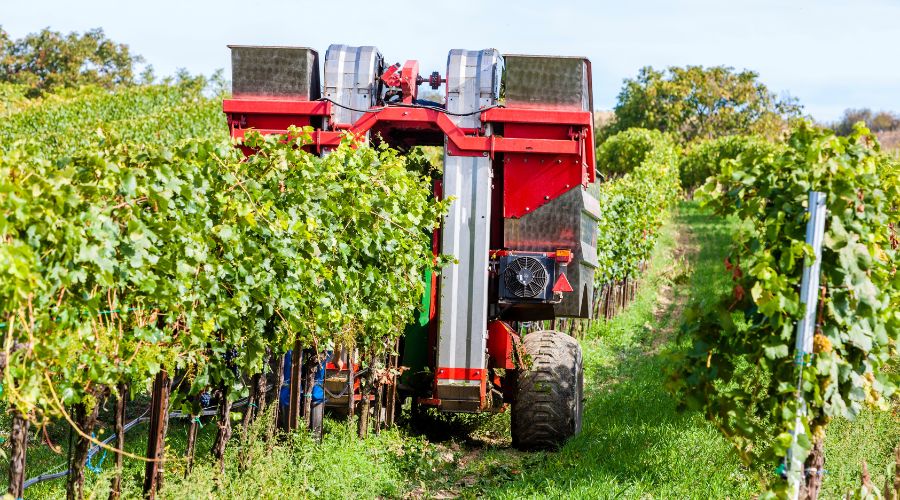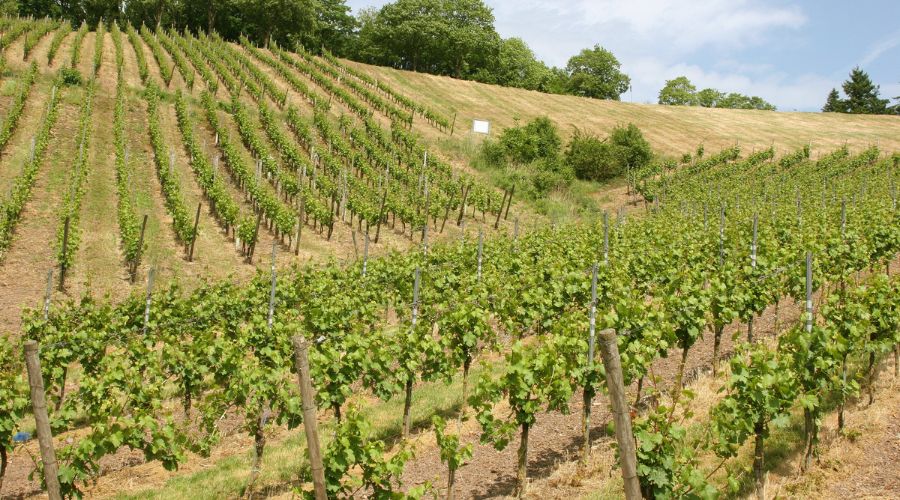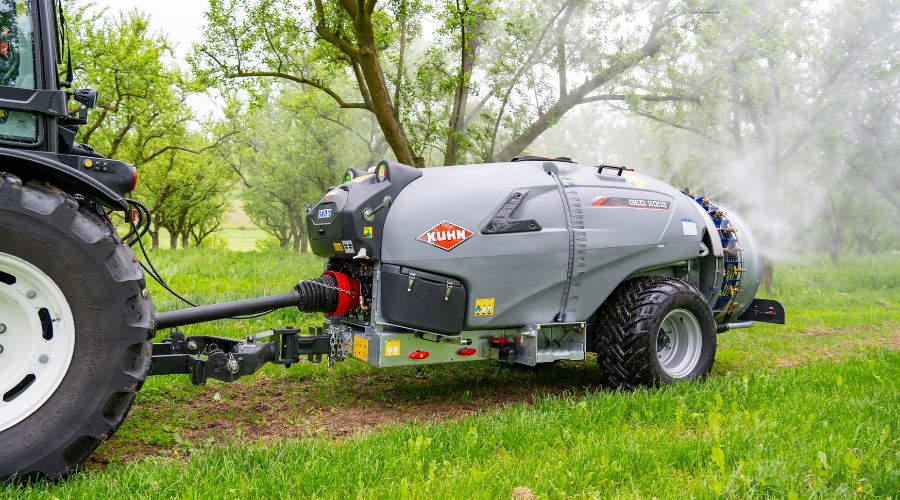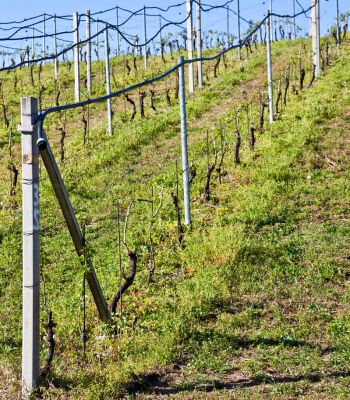Preparing your vineyard for mechanisation
19th June 2025
The UK’s growing wine industry faces a critical challenge: labour shortages and rising costs are pushing growers to consider mechanisation as a solution.

Mechanising vineyard tasks – from pruning to bud rubbing to harvest – can help deliver consistency, timeliness and cost savings, allowing operations to stay viable. Globally, winegrowers are increasingly turning to machines to handle vineyards with fewer workers, performing tasks more efficiently.
Yet, mechanisation is not just a simple fix; it requires careful planning and well-thought-out infrastructure. The goal is to reduce manual labour without compromising on quality, which means designing or adapting vineyards so machines can operate effectively and efficiently.
Whether you’re establishing a new vineyard or retrofitting an existing one, thinking ahead about vineyard mechanisation will pay dividends in labour savings, consistency of operations, and long-term efficiency.
Is your vineyard mechanisation-ready?
Not every vineyard can be easily mechanised. Before investing in equipment, evaluate whether your site and setup are suitable:
Terrain and soil – Steep slopes can be dangerous for tractors or harvesters – grades above ~15% are generally too steep for safe mechanised operations, whilst slopes of 3-5% are manageable and still allow cold air drainage. Good soil drainage is essential, as mechanised tasks can increase soil compaction and compacted or waterlogged soils can affect yields and reduce efficiency.
Installing drainage systems and using cover crops to enhance soil structure may be necessary. Shifting toward low-compaction equipment and/or using low-ground-pressure tyres or crawler tracks, and subsoiling compacted areas can protect your vineyards’ productivity as mechanisation increases

Row spacing and layout – Row width must suit your equipment. While some straddle tractors can work in rows as narrow as 1.2m, most vineyard tractors and implements require 1.8m or more. Straight evenly spaced rows aid efficiency.
Headlands – the space at row ends for turning – should be 10-12m wide to accommodate machinery. Narrower headlands or obstacles like trees and posts can hinder operations. Long, uninterrupted rows reduce the frequency of turns and increase operational efficiency
Trellising and canopy structure – Trellis strength and design determine whether machines can perform tasks like trimming or harvesting. Vertical shoot positioned (VSP) or single-curtain cordon systems are best. Trellises must be sturdy, with taut wires and robust end-post assemblies.
Metal posts are often preferred over wooden or concrete alternatives, especially when using harvesters, which generate significant vibration. Vines planted unevenly or with irregular gaps can confuse machines and reduce performance, so uniformity is key
Vineyard size and economics – Mechanisation of a vineyard becomes more viable as size increases, given the cost of equipment. For smaller vineyards, sharing or contracting machinery is a cost-effective option.
Starting with versatile attachments for an existing tractor, such as sprayers or trimmers, can ease the transition without heavy capital investment. Always calculate the total cost of new machinery or equipment, including fuel, maintenance, and training against potential labour savings
Skilled labour and training – While mechanisation reduces manual labour, it increases the need for skilled operators. Tractors, pruners, harvesters, and sprayers all require careful handling to avoid damaging vines or underperforming.
Training is essential, and investing in experienced operators or upskilling your current team goes hand-in-hand with investing in the equipment. In short, a vineyard is “ready” for mechanisation when both its physical setup and its people are prepared for the change.
Now that we’ve covered site, trellis, layout, and economics of vineyard mechanisation, you should be able to more easily identify which aspects of your operation are mechanisation-friendly and which may need adjustments. Next, we’ll take a look at specific vineyard operations that can be mechanised, and what infrastructure changes each may require.
Mechanisable operations and requirements
Many vineyard tasks can be mechanised with the right equipment and vineyard configuration. Below we break down key harvesting operations – from soil management to harvesting – and discuss how that can be done by machine, what infrastructure is needed, and what to consider when adopting mechanical methods.
1. Trellising
The trellis is a critical interface between vines and machinery. It has to support consistent canopy structure while withstanding mechanical force during pruning, trimming, spraying, and harvesting. Mechanised vineyards require uniformity, strength and a training system that matches tool geometry.
According to VineWorks’ business director Chris Buckley, “If you’re thinking about introducing machinery to your vineyard, your trellis system needs to be ready to take the load – quite literally.” His key recommendations include:
- Durability matters – hot-dipped galvanised metal posts (1.5mm for intermediate posts, 2.5mm for end posts) can handle small knocks from machinery
- Keep it level – consistent post height helps prevent accidents and makes mechanical passes smoother
- Wire tension is key – tight wires maintain canopy shape and stability, enabling efficient use of leaf strippers and trimmers
- Strong end assemblies – good anchors keep the system together during high-load activities like pre-pruning or harvesting.
Infrastructure preparations: metal trellising with braced end posts, uniform wire height, tight wires, a training system compatible with machinery (e.g. VSP or cordon), and row spacing wide enough for tractor access.
2. Canopy management
From pruning to shoot thinning, many canopy tasks can be partially or fully mechanised.
- Winter pruning: pre-pruners and cane-pulling machines reduce labour but require simple, linear trellis systems
- Bud rubbing and shoot thinning: rotating bars or sucker removers can clean trunks. Vines must be uniformly trained
- Shoot tucking and wire lifting: systems like Provitis can lift catch wires and secure shoots, though twine management adds labour
- Leaf removal and trimming: mechanical removers and trimmers can perform 80-90% of canopy management if the trellis canopy is uniform.
Machines are efficient but non-selective, often requiring manual touch-ups.
Infrastructure preparations: VSP or cordon trellising, consistent canopy height, strong posts, twine disposal plans.

3. Weed, Pest and disease control
Spraying can be fully mechanised using tractor-mounted sprayers:
- Air-blast and tunnel sprayers ensure even coverage and allow fast application during dry windows
- Under-vine sprayers or mechanical weeders offer chemical and non-chemical options
- Sensor-guided sprayers (LiDAR or ultrasonic) reduce waste by adjusting spray output to canopy density.
Precision tools are increasingly being used to reduce chemical waste and improve application accuracy. “Airblast spraying is prone to significant issues like drift, overspray, compaction… Cordon’s loop real-time mixer integrates seamlessly with existing sprayers, allowing farmers to control what they spray and where, reducing waste by enabling real-time tank mixing,” says Cordon Technologies’ CEO, Jamie Hutchinson.
Infrastructure preparations: wide rows and headlands, reliable water supply, trained operators, tractors with hydraulic/PTO capabilities.
4. Irrigation and fertilisation

Though not yet widespread in British vineyards, drip irrigation is gaining traction, especially on free-draining soils.
- Drip systems: deliver water directly to vines, often mounted on trellises to avoid machine damage
- Fertigation: allows nutrient dosing through the same system
- Automation: timers or moisture sensors enable precise scheduling, sometimes integrating frost protection.
Infrastructure preparations: reliable water source, pumps, filters, drip lines, automated controllers, and protected pipe placement.
5. Harvesting
Mechanical harvesters can reduce harvest labour from a large crew to a single operator, but require:
- Straight rows (2-3m wide): most self-propelled or towed harvesters straddle the vine row and need consistent spacing to operate safely
- Upright canopies (VSP): vertically trained canopies present fruit in a uniform zone that harvesters can target
- Strong trellises with reinforced posts and tensioned wires: harvesters apply significant lateral and vertical forces when shaking the canopy
- Flat or gently sloping terrain: most modern harvesters can operate on slight gradients, but steep slopes risk rollover or uneven picking.
- Consistent fruiting zone height: to maximise picking efficiency, the fruiting zone should align with the harvester’s shaking and collection head.
Contract harvesting is increasingly available for smaller British vineyards. Modern machines offer gentler handling and integrated sorting systems, reducing quality concerns. If retrofitting, you may need to adjust trellis height, replace weak posts, or widen alleys.
Infrastructure preparations: access for harvesters, sturdy trellising, winery capacity for rapid processing, sufficient bins or trailers.
6. Monitoring and data collection
Mechanised vineyards benefit significantly from precision monitoring tools that guide decision-making and optimise equipment use. Real-time data helps target operations, improve consistency, and reduce waste.
- Install canopy sensors to measure temperature, humidity, and light penetration – key indicators of plant stress and spray effectiveness.
- Use soil moisture probes and EC meters to tack water availability across vineyard blocks
- Adopt GPS-guided tractor systems to map operations like spraying and pruning, enabling repeatability and better record keeping
- Deploy drones for aerial imaging and normalized difference vegetation index NDVI analysis to assess canopy health and identify problem areas
- Integrate weather stations and disease risk models to better time fungicide or insecticide applications based on forecast conditions.
Infrastructure preparations: telemetry-capable canopy and soil sensors, weather stations, GPS-equipped machinery, aerial imaging tools, data dashboards, and compatible mapping or decision-support software.
“Systems like TruePest automate monitoring and provide growers with real-time pest alerts and dynamic dashboards,” says Rachel Turner, technical product specialist at Russel IPM. “This supports better decision-making, even where agronomy time is limited, and ensures interventions are based on current, accurate data.”
7. Frost protection
Frost remains a major threat in the UK. Mechanised defences include:
- Wind machines that pull warmer air down to protect buds
- Overhead sprinklers that cover vines in a layer of water that release latent heat as the water freezes, maintaining bud temperatures at 0oC
- Spray on barriers, like foams or coatings that insulate.
Both systems benefit from automation triggered by temperature sensors.
Infrastructure preparations: site access, planning permission (for fixed fans), high-flow water source, automated controls, and operator training.
Retrofitting vs. new plantings
We’ve summarised the key factors to weigh up whether you’re retrofitting an existing vineyard or starting from scratch with a new site. Each route brings its own challenges and opportunities, but both benefit from thoughtful design and a clear focus on mechanisation from the outset.
Retrofitting existing vineyards
Adapting established vineyards for mechanisation involves several considerations:
- Row modification – Adjusting row widths to accommodate machinery, which may include removing alternate rows or reconfiguring existing ones
- Trellis reinforcement – Upgrading trellis systems to ensure they can withstand mechanical operations, such as harvesting and pruning
- Infrastructure improvements – improving access roads, headlands, and turning areas to facilitate machinery movement
- Cost-benefit analysis – evaluating the economic feasibility of retrofitting versus potential gains in efficiency and yield.
In many cases, growers can phase in mechanisation gradually, starting with targeted operations such as spraying or pre-pruning before attempting full canopy automation or machine harvesting. This staggered approach can help manage investment and reduce disruption to operations.
Designing for mechanisation
When planning new vineyards with mechanisation in mind, consider:
- Optimal layout – implementing straight rows with consistent spacing to facilitate machine operations
- Trellis system selection – choosing trellis designs compatible with mechanised equipment, such as VSP
- Infrastructure planning – designing adequate headlands and access points for machinery, considering future scalability
- Technology integration – incorporating monitoring systems and automation from the outset to enhance vineyard management.
Uniformity is essential – establishing a well-thought-out layout and infrastructure during the design phase makes later adoption of advanced machinery far easier, and future-proofs the vineyard for upcoming developments in viticultural technology.
Mechanising a vineyard isn’t just about buying equipment – it’s about building a system that supports it. That means designing or adapting your site, training staff, and investing in infrastructure that enables efficiency.
Start with the most impactful tasks – spraying, pruning, canopy work – and scale gradually. For many British vineyards, the move to mechanisation is no longer optional. With thoughtful planning and targeted investments, even small or mid-sized operations can realise the benefits.
Vineyard mechanisation is a journey – but one that leads to greater resilience, improved productivity, and long-term sustainability.
Read more vine news.
